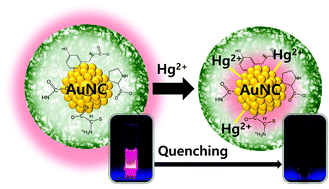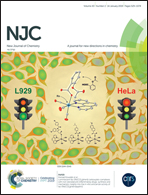Environmentally benign and cost-effective synthesis of water soluble red light emissive gold nanoclusters: selective and ultra-sensitive detection of mercuric ions†
Abstract
Heavy metal pollution is a potential threat because it exerts severe harmful effects on the environment and human health. Hence, the rational design and fabrication of fluorescent probes for the simple, selective, and sensitive detection of heavy metal ions are of great significance. In this article, we have reported an environmentally benign, green and cost-effective approach for the synthesis of red luminescent gold nanoclusters (AuNCs) using wheat flour as the stabilizing and capping agent. The resultant AuNCs have been characterized by several spectroscopic and microscopic techniques. We have achieved a high quantum yield (9.02%) for the red fluorescent AuNCs, with a maximum emission wavelength of ∼640 nm under 370 nm excitation. We have successfully applied the synthesized AuNCs for the nanomolar detection of Hg2+ in an aqueous medium via selective fluorescence quenching of the AuNCs in the presence of several other metal ions. We have attained a limit of detection (LOD) as low as 7 nM for Hg2+ and the selectivity of detection is attributed to the specific interaction between the Hg2+ ions and the Au+ ions present in the AuNCs.



 Please wait while we load your content...
Please wait while we load your content...